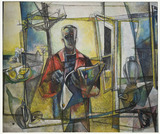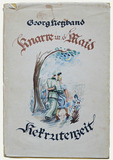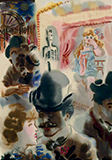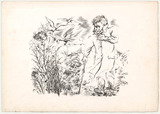Georg Kaiser, Das Floss der Medusa [„The Raft of the Medusa“], manuscript
A children’s tragedyGeorg Kaisers immense creative power remained in full spate after 1933 and during the seven years of his exile in Switzerland. Between 1938 and 1945, he wrote nine dramas in all; these were premièred at theatres in Basel and Zurich and published by Querido and Oprecht.
Georg Kaiser: Notes on the Lenz publishing house (1944)
My own publishing project in Swiss exileIn April 1944, Georg Kaiser informed his businessman friend Julius Marx about his plans for the future, namely "founding a publishing house and theatrical distribution agency". In a letter to Marx from October 1944, he describes the project as his "second mission in life", a position which he also maintained in the following months with vehemence.
Georg Kaiser's Das Floss der Medusa (1945) in the Theater-Zeitung Basel
Announcement of premiereGeorg Kaiser's drama Das Floss der Medusa, named after the painting by Théodore Géricault, was premiered on 24 February 1945 at Stadttheater Basel. The fact that the director Robert Pirk dared to stage it with an ensemble made up entirely of school pupils was deemed a "courageous effort" by Kaiser, who had long waited in vain for a stage performance.
Georg Kaiser’s membership card, issued by the Reichsschrifttumskammer (Reich Chamber of Literature)
Member 11160On 5 May 1933, Georg Kaisers was excluded from the Prussian Academy of the Arts. The NSDAP newspaper Völkische Beobachter had previously anathematised the famous Expressionist dramatist, claiming that the play Der Silbersee [The Silver Lake], set to music by Kurt Weill and successfully premièred in Leipzig in February, was “un-German” and “cultural Bolshevist” propaganda.
Georg Meistermann: Der Maler (The Painter, 1941 – 1943)
Georg Meistermann was a student at Düsseldorf’s Art Academy when it was forced to toe the Nazi line in 1933. However, Meistermann did not want to fit in.
Georg Netzband, Der Sieger (Mai 1939)
For the painter Georg Netzband, life in Nazi Germany meant living with state repression. The indignities included surveillance and interrogations, house searches, defamation as a “degenerate” artist and bans on exhibiting his work and on foreign travel.
Georg Netzband: Knarre und Maid – Rekrutenzeit (1938)
A work on the “list of damaging and undesirable writing”Due to supposed political unreliability, Georg Netzband was subjected to repression in the form of interrogations as well as searches of his house and studio. The situation escalated to such a point over the years that he began to seek a means of temporarily escaping the persecution. So in 1938, he took part in a military exercise lasting several weeks.
George Grosz: portfolio Bagdad-on-the-subway, watercolour (1935)
In 1932 the painter and illustrator George Grosz visited the US for the first time. Fascinated by the bustling city, Grosz wandered the streets of New York with a pencil and notebook recording every detail.
George Grosz: Portfolio of Lithographies Interregnum (1935)
With his Interregnum portfolio, three years after his permanent emigration to the US in early 1933, the painter and illustrator George Grosz published his last works that were directly connected to his political works in the Weimar Republic. In the portfolio, Grosz included drawings made between 1928 and 1935.
George Grosz: The Musterbook – Textures (1940-1958)
In America as well, George Grosz never stopped creating collages out of photos and pictures from newspapers. This technique was above all associated with his work on the DADA scene after the First World War during his time in Berlin, when Grosz worked together with John Heartfield, Raoul Hausmann and other DADA artists.
![Manuscript: Georg Kaiser, Das Floss der Medusa [„The Raft of the Medusa“] Manuscript: Georg Kaiser, Das Floss der Medusa [„The Raft of the Medusa“]](/KIE/Content/EN/Images/objects/kaiser-georg-das-floss-der-medusa-manuskript-en.jpg?__blob=thumbnail&v=4)
![Manuscript: Georg Kaiser, Das Floss der Medusa [„The Raft of the Medusa“] Manuscript: Georg Kaiser, Das Floss der Medusa [„The Raft of the Medusa“]](/KIE/Content/EN/Images/objects/kaiser-georg-das-floss-der-medusa-manuskript-en.jpg?__blob=thumbnail&v=4)









